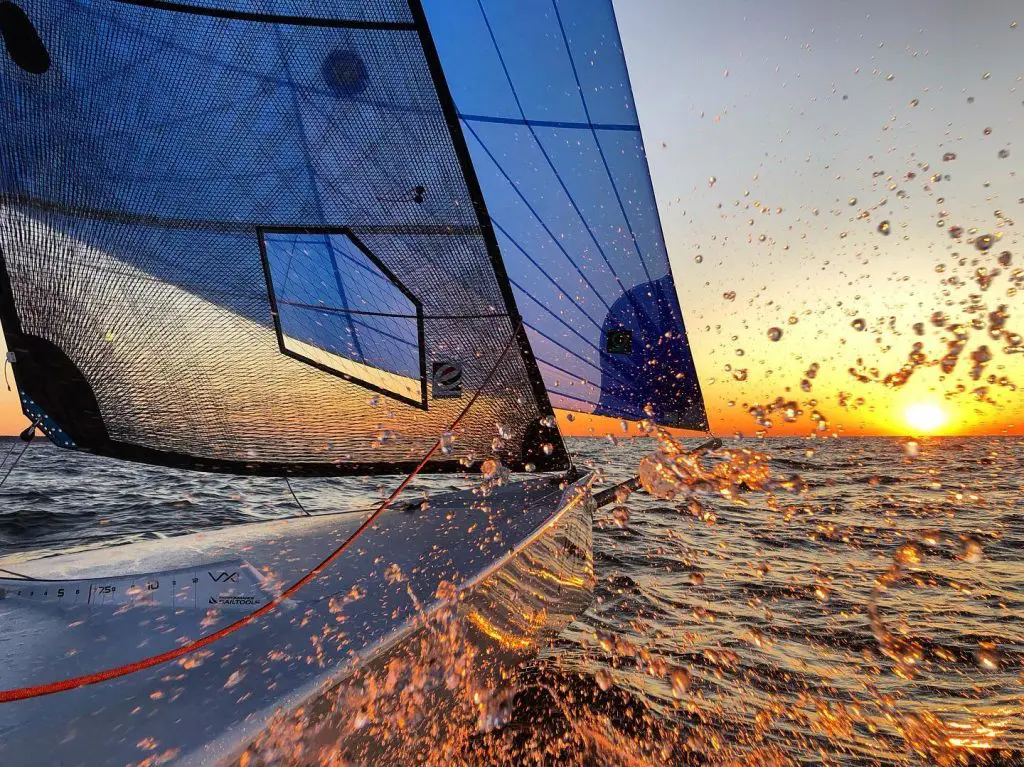Mylar Sails Aren’t So Scary
Ask any sailor who raced on boats during the mid-1990’s or early 2000’s about mylar sails and they are sure to tell you about the horrors of that cursed material. Sails disintegrating before your eyes, endless taping of holes, and worst– the unbearable crinkling sound a delaminating sail makes as you roll it!
We’ve heard it all. It has been the “Bogey Man” of the sail making industry since the advent and worldwide adoption of Mylar-laminated sails. While simply uttering the word “Mylar” may still leave a sour taste in some mouths, what was originally blamed on the material itself may have in fact been the fault of poor sail construction.
What is Mylar?
First of all, what is Mylar? Chemically speaking, Mylar is simply a polyester film that has a wide range of uses from electronics to food package and of course, sails. The name Mylar is actually a trade name originating from the manufacturer, Dupont, describing BoPET (biaxially-oriented polyethylene terephthalate), and most of that mouth-full is just to say that it has been stretched in two directions.
When Was Mylar First Used in Sails?
The material has been around since the 1950’s with the earliest Mylar sail built in 1955 (https://www.sailingscuttlebutt.com/2017/03/08/mylar-sails-began/) and promptly banned for being too fast! After a comeback in the 70’s, the widespread adoption started to take over the sailing world in the 1990’s and early 2000’s. Today, Mylar is one of the most commonly used materials in the sail making industry. Originally used to reinforce woven Dacron and Aramid sails, Mylar is now the backbone of laminated panel and membrane sails.
Mylar is a choice material in sails because it has a high tensile strength in all directions and is stable enough to hold up to the extreme offshore environments we sailors call home. Its ability to hold its strength in all directions pairs well with the more focused support of load bearing fibers.
Mylar Sail Failures & Bad Rap
Mylar earned a bad rap over the years due to the failures of early laminated sails. Some failed in spectacular fashion on their first hoist while others slowly succumbed to delamination. Since Mylar accounted for most of the sail material, it took much of the blame. The real culprits, however, were poor lamination technique and inferior choices in glue. Many sailmakers blamed sail delamination on the material to hide the sails’ faulty construction.
The issues with early laminate sails are linked to the use of heat sensitive glue, really nothing more than a fancy version of the glue sticks in a hot glue gun. After exposure to multiple heat cycles, the fiber and mylar skins would slowly move out of place until the structural integrity of the sail was compromised. Modern laminate sails like Evolution Membranes use a glue that relies on chemical bonds, meaning once the sail has cured, the glue is no longer sensitive to heat and will not degrade even after continuous heat cycling. Evolution sails also undergo a secondary curing process under heat blankets known as post-curing, ensuring the entirety of the glue has cured for an even tighter bond.
The other half of the issue with early laminated sails came from poor lamination techniques used by sailmakers at the time. Imagine that building a laminated sail is like baking a cake; you need the right ingredients, mixed in specific ratios, with the proper heat, for the correct amount of time. Now consider where the very first cake recipe came from. While the basics come from the chemistry of baking and known properties of the ingredients, the recipe is never perfect without a generous amount of trial and error. This stage of development was often overlooked by sailmakers building early laminated sails.
Generally, the problems stemmed from not using enough pressure when gluing or using the wrong combination of heat and time which caused the layers to become un-stuck from each other.
Evolution From Mylar to Membrane Sails
Fortunately, the days of hoisting Mylar sails that doused themselves only after a short time in the air are far behind us. The issues addressed in this article have been solved after a decade or two of repeated trial and error. Modern laminated sails are built using better glues, higher pressures, and more precise heat and cook times.

Technological Advancements
Other advancements have been made over the years as well, such as the use of internal batten pockets and corner/reef point reinforcements, reduced glue content, and a better understanding of the forces a sail must sustain to remain intact.
These advancements have increased the durability and strength while simultaneously decreasing the overall weight. The sails coming out of Evolution’s EM2 plant in New Zealand are proving to be some of the toughest sails ever to have been produced, having never suffered a delamination event while being equipped on racing and cruising boats all over the world.
Talk With A Sailmaker
Want to learn more about more about sail material? Contact us and we will be happy to discuss this topic in detail with you and determine which materials are best suited to your use, or try our online sail builders, which uses our artificial intelligence to help select what kind of sail is right for your sailboat.



